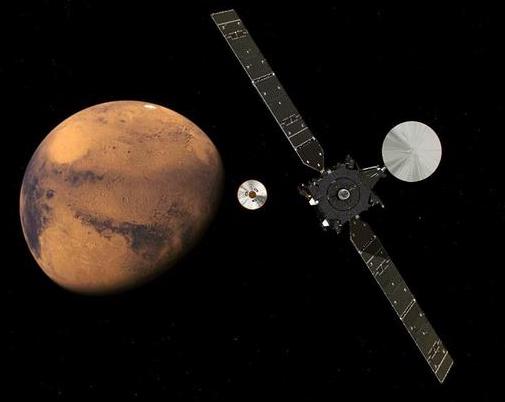Schiaparelli is designed to monitor aspects of the Red Planet’s weather rather than probe for alien life, as per reports. The module will also examine a landing system which is going to be used for a rover mission in the future, to search for signs of both past and present life on Mars.
According to BBC News, the lander separated from the Trace Gas Orbiter (TGO) at 14:42 GMT (10:42 am Eastern time) on Sunday, and is expected to make contact with the highest point of the planet’s atmosphere on Wednesday. Once it does so, it will have just over five minutes to reduce its speed from 13,000 mph (21,000 km/h) to zero in order to make a soft(-ish) landing.
The separation was confirmed thanks to a signal beamed from the TGO back to controllers at the ESA facility in Darmstadt, Germany, the British news outlet said. What happens next will be out of their hands, as Schiaparelli’s landing sequence is fully automated – ground control will not be able to change the spacecraft’s trajectory of input new commands from this point forward.
In addition to serving as a technology demonstration, proving that the ESA is capable of sending a lander to the Red Planet following a failed attempt with the Beagle 2 in 2003, Schiaparelli will be monitoring the Martian weather and will be testing out a landing system which will be used in a future mission that will hunt for signs of life, according to The Guardian.
How the two-part mission will move forward from here
As the lander draws closer to the Martian surface, it should experience a reduction in speed due to the interaction of the planet’s atmosphere with its heatshield, BBC News said. It will also use a large parachute and rockets to significantly lower its velocity until it is just 2 meters (6.5 feet) above the surface, when it will simply fall to the ground on its undercarriage.
During this process, it will be emitting UHF tones which will be detected by a radio telescope in India, then relayed on to mission control personnel in Darmstadt. If the telescope can still detect the vehicle’s signals by 15:00 GMT (11:00 am Eastern) on Wednesday, it means that the landing was successful and that the approach will likely work for the agency’s upcoming ExoMars 2020 mission.
On Monday morning, ESA officials announced that the TGO had also successfully completed an orbit-raising maneuver required to prevent it from crashing into the planet’s surface. The orbiter fired its engines for just under two minutes, raising its altitude by several hundred kilometers and putting it into position for orbital insertion – a maneuver that is also scheduled for Wednesday.
The ExoMars mission is a collaboration between the ESA and the Russian-based Roscosmos State Corporation for Space Activities, and in addition to the lander’s activities, the orbiter will be creating a detailed inventory of the different gases in the Martian atmosphere. However, due to a complex series of aerobraking maneuvers needed to correct its orbit, TGO is not expected to begin its science operations until late 2017, the agency had previously reported.
Maxine J. Martin













